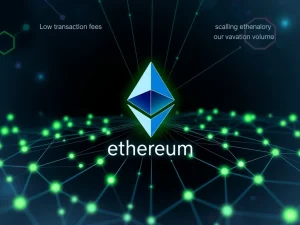Ethereum Scaling: Pico Prism Unleashes Revolutionary Real-Time Proving, Paving Way for 10K TPS

The quest for enhanced Ethereum scaling has taken a monumental leap forward. Indeed, a recent breakthrough promises to revolutionize how we perceive blockchain validation. Consequently, this development brings the network closer to achieving an ambitious goal: processing 10,000 TPS (transactions per second). Crypto enthusiasts and developers are watching closely. Furthermore, the implications for decentralized finance (DeFi) and broader adoption are significant. Ultimately, this advancement addresses long-standing challenges within the Ethereum ecosystem.
Unlocking Ethereum Scaling with Pico Prism
Brevis, a leading Ethereum scaling firm, recently unveiled Pico Prism. This innovative technology represents a state-of-the-art zero-knowledge Ethereum Virtual Machine (zkEVM). It offers real-time proving capabilities. Significantly, Pico Prism achieves this using readily available consumer GPUs. This eliminates the need for expensive supercomputers. Brevis specifically utilized 64 Nvidia RTX 5090 graphics cards for testing. These are flagship models for gaming. This choice underscores the accessibility of the new proving method. The firm announced its findings this past Wednesday. This marks a pivotal moment for the network’s future. It paves the way for unprecedented efficiency. Moreover, it broadens participation in validation processes.
The Power of Real-Time Proving
Real-time proving (RTP) fundamentally transforms blockchain validation. It involves generating a cryptographic proof for a block’s correct execution. This process must occur faster than new blocks are produced. Brevis conducted a crucial test in September. During this test, Pico Prism achieved an impressive 99.6% real-time proving rate. It completed this in under 12 seconds. This speed surpasses current block production times. This accomplishment signifies a major stride. It moves Ethereum toward 100x scaling. Furthermore, it envisions a future where users can validate the chain directly from a phone. The technology effectively turbocharges real-time proving. Brevis plans to optimize further. They aim for 99% real-time proving with fewer than 16 RTX 5090 GPUs. This goal should be met within the next few months. This efficiency drastically reduces hardware requirements. It makes validation more accessible to everyone.
Understanding zkEVM Technology
The core of this innovation lies in zkEVM technology. Zero-knowledge Ethereum Virtual Machines are cryptographic systems. They allow for the verification of computations without revealing the underlying data. Traditionally, every validator re-executes every transaction. This ensures block validity. This method requires significant computational resources. It also creates a fundamental bottleneck for scalability. Brevis’s approach breaks this established model. One prover generates a proof. Subsequently, everyone else verifies it in milliseconds. This verification process is incredibly lightweight. It reduces the computational burden dramatically. Therefore, it enables a much higher transaction throughput. This shift is critical for Ethereum’s long-term growth. It enhances both efficiency and security.
The Path to 10,000 TPS
The ultimate goal for Ethereum is reaching 10,000 TPS. This ambitious target is a key part of the network’s roadmap. Validators will eventually transition from re-executing transactions. Instead, they will simply verify ZK-proofs. This change allows the base layer to achieve unprecedented speeds. Ryan Sean Adams from Bankless projects a timeline. He suggests Ethereum L1 could reach 10,000 TPS by April 2029. This projection assumes a 3x annual scaling rate. This shift represents a monumental architectural change. It will unlock new possibilities for decentralized applications. Furthermore, it will support a global user base. The ability to handle such a high volume of transactions will solidify Ethereum’s position. It will become a dominant force in the digital economy.
Fusaka Upgrade and Future Optimizations
Upcoming Ethereum upgrades will further streamline this path. The Fusaka upgrade, expected in December, plays a vital role. Bitcoin security researcher Justin Drake explained its significance. It will simplify real-time proving processes. Specifically, EIP-7825 will cap per-transaction gas usage. This enables more parallel proving through subblocks. This means multiple proofs can be generated simultaneously. Drake anticipates rapid progress. By year’s end, several teams will prove every L1 EVM block. They will use a 16-GPU cluster. This setup will draw less than 10kW total. Such efficiency underscores the rapid advancements. It highlights the commitment to sustainable scaling solutions.
A Decentralized Future: Phone as a Node
This technological leap brings a crucial vision closer: the ‘phone-as-a-node’ future. The Ethereum Foundation acknowledges this. They stated, ‘ZK technology like Pico Prism will enable Ethereum to scale to meet global demand, while still remaining trustworthy and decentralized.’ This emphasizes the dual benefit. Scalability meets robust decentralization. Tech entrepreneur Mike Warner echoed this sentiment. He declared, ‘The phone-as-a-node future just got real.’ Ryan Sean Adams from Bankless provides further insight. He explains Ethereum’s transformation into a zk-chain. The Layer 1 will manage global DeFi. It will feature big blocks at 10,000 TPS. Nodes will run on a phone. Meanwhile, Layer 2 solutions will handle everything else. This architecture represents the holy grail of blockchain. It delivers massive scalability without sacrificing core principles. These principles are decentralization and security. This future promises broad accessibility. It also ensures network integrity.
Pico Prism’s advancements mark a significant milestone for Ethereum. The ability to achieve real-time proving with consumer GPUs is a game-changer. It accelerates the journey towards 10,000 TPS and a truly scalable, decentralized network. The integration of zkEVM technology promises efficiency and security. Moreover, it brings the ‘phone-as-a-node’ vision into clearer focus. This innovation empowers individuals. It strengthens the entire ecosystem. As Ethereum continues its evolution, these breakthroughs will redefine its capabilities. They will solidify its role as a foundational layer for the future of finance and technology.









